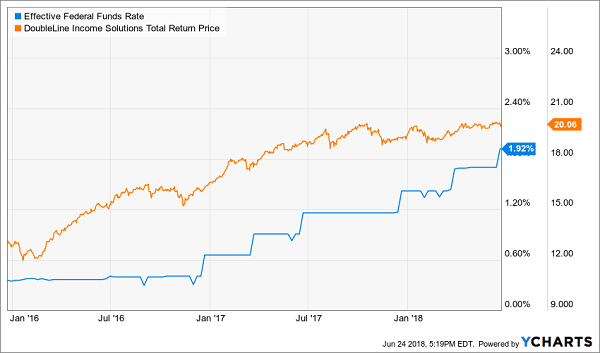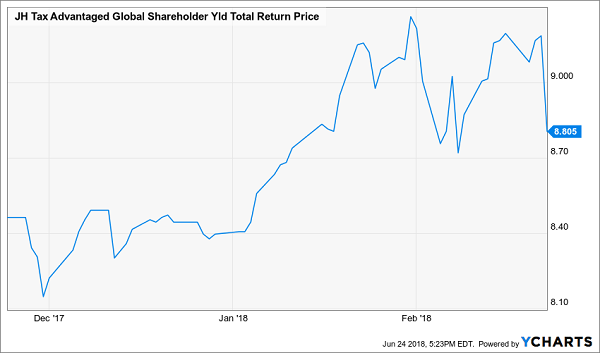“You can really find 7% yields today? Safe ones?”
“Where???”
My personal trainer – a financially savvy person and investor – didn’t believe it.
He’s a young guy with two or three decades of active income left, so he’s as interested in building a giant pile of cash as he is in collecting dividends. So when I told him about closed-end funds (CEFs) – and the capital gains available in this inefficient market – he was blown away.
My kettlebell guru isn’t the only one, according to the big response we received from last week’s piece about “advanced level” CEF investing. So I asked our in-house CEF Professor Michael Foster to join us for an interview. He kindly agreed.
Michael’s CEF Insider publication is dedicated to diversified, nuanced 7%+ yields with 20%+ upside potential. If you like the idea of bagging bargain dividends and getting paid while you lock in big capital gains to boot, you’ll love this interview.
Brett Owens: Michael, many CEF investors are worried about rising rates. What types of funds are you looking at for your subscribers to help them “rate-proof” their CEF holdings?
Michael Foster: U.S. equities go up during rising rates, with small-caps and mid-caps tending to outperform mega-caps, with the exception of tech stocks (this is why Nasdaq 100 and S&P 500 are beating the Dow). So I am much more interested in GAM, HTD, ASG, and SOR and less excited about DIAX, but I think any U.S. equity fund should do well in the near term.
Also, of course, floating-rate loans are directly connected to rising rates—they go up as rates rise. There are 31 floating-rate loan CEFs out there; I’ve recommended one to my subscribers, but I’m also interested in DSU, AFT, and BGX as possible future picks.
Floating-Rate CEFs Rise with Rates

BO: And how about increasing leverage costs? Won’t that be an automatic damper on CEF income?
MF: Not automatically. If a fund’s returns—the profits it makes on investments, whether that’s investment income from bonds/loans or capital gains from stocks or something else—stay constant and their leverage costs go up, the fund’s income will have to decline.
However, that’s not really possible; when rates go up, that tends to mean a booming economy, which means a lot of different investment returns go up too.
For instance, the S&P 500 has gone up 19% annualized since the Fed started hiking interest rates in 2015, which is even better than the 16% annualized return the S&P 500 had from the bottom of the Great Recession crash in early 2009. So, yes, CEFs will have to pay more in leverage costs—but the good CEFs will also get higher returns, because there are higher returns to be found by savvy fund managers.
The “Bond God’s” CEF Delivers as Rates Rise

BO: Let’s talk about fund size – I alluded to this in last week’s column, with the advantage that CEFs tend to have over ETFs. In my opinion, we can extend this advantage to within CEF-land, too. What advantage do smaller CEFs have over larger ones?
MF: The biggest advantage of smaller CEFs is their sheer obscurity, which creates market inefficiencies that investors can profit from. For instance, I recommended HTY in November 2017 when it was trading at a huge discount much bigger than its average premium price. HTY swung to a premium mere months later—giving my subscribers a 15.8% annualized return when I recommended selling it.
The Professor’s Quick Gain on HTY

Another advantage is that smaller CEFs with big discounts to NAV (net asset value) tend to get merged with bigger CEFs (this has already happened to one of CEF Insider’s picks). When that happens, the CEF’s discount to NAV tends to disappear, providing additional profits on top of the strong and high income stream provided by the fund.
BO: Price upside is another underrated potential benefit of CEFs. When you buy right, you can enjoy capital gains from NAV appreciation and/or a discount window closing (or even swinging to a premium). Given the backdrop of rising rates, are you looking more to NAV gains or closing discount windows as the big driver of your funds’ upside?
MF: I am focused more on NAV gains right now. I think that a lot of CEFs are invested in assets that I am extremely bullish on. One fund I’ve recommended has a double-digit discount that has stayed still since I recommended it, but it’s up 16% in less than a year simply because its excellent portfolio has risen in value.
However, I do think when we are later in the economic cycle (perhaps in a year or two), we will see discount windows close as a result of market exuberance. That may be the beginning of a bubble, and I’m biding my time before recommending greater caution and defensiveness for my subscribers. Until then, however, the market looks extremely healthy and the rise in stocks and bonds seems based much more on fundamentals than irrational greed.
BO: We just started the second half of 2018 (as usual, the first half flew). Give us a CEF outlook and your thoughts for the “back six months” here. What types of CEFs are you looking at for nice yields with price upside for the rest of the year?
MF: The first six months of 2018 were a great buying opportunity, if a bit nerve-wracking. I spent a lot of time encouraging readers to stay calm, do not sell, and enjoy the widening discounts of the period. We saw discounts grow considerably because of panic selling but NAV performance remaining pretty strong.
Now in the last few weeks, we’ve seen the market reverse course; now discounts are getting smaller, and subscribers who bought in the first half of the year are already sitting on large profits that are set to grow larger thanks to the strong economic backdrop that’s pushing these funds’ assets higher.
For the rest of the year, I’m most interested in U.S. equity funds with a particular sector focus; there are some energy funds, utilities funds, and technology funds I think are pretty interesting. I am also interested in more floating-rate loan funds, since I think interest rate hikes are going to keep coming hard and fast.
BO: Thanks, Michael.
Publisher’s Note: We launched Michael’s CEF Insider publication in March 2017 thanks to overwhelming demand for more CEF ideas – with a special focus on high upside opportunities.
As you probably know, Brett loves recommending CEFs for his Contrarian Income Report subscribers. But with 10,000+ members, he must focus on highly traded, highly liquid opportunities.
This is where our CEF Professor comes in. When his computers recognize an under-the-radar opportunity, Michael issues a buy recommendation to his “limited seat” CEF Insider subscriber base. He’s dedicated to finding nuanced 7%+ yields with 20%+ upside potential.
If you like the idea of big upside in addition to big dividends, you should see which CEFs are flashing B-U-Y according to Michael’s timing system today. Click here to for the Professor’s latest analysis and best buys (along with tickers and fund names).
Kevin Wallen, Publisher

Recent Comments